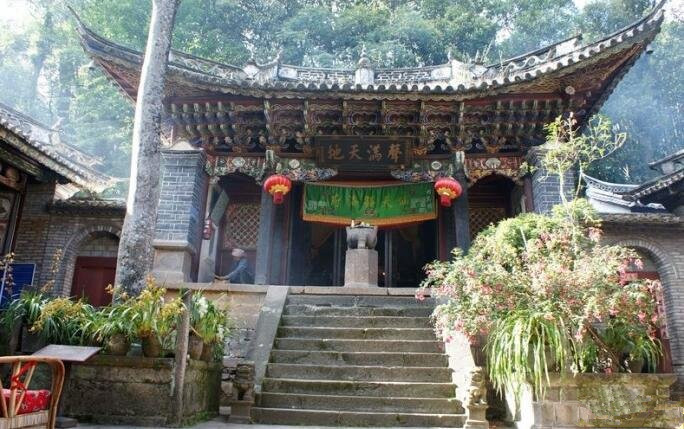
Lingguan Temple of Weibao Mountain in Weishan County, Dali
Lingguan Hall (灵官殿) is a Taoist temple primarily dedicated to the Dharma Protector deity Wang Lingguan (王灵官). Located on the front mountain of Weibao Mountain (巍宝山) in Weishan Yi and Hui Autonomous County (巍山彝族回族自治县), Dali Prefecture, Yunnan Province, it was originally built during the late Ming and early Qing dynasties. The hall is aligned on the same central axis as Yuhuang Pavilion (玉皇阁), forming the entrance gate of the Yuhuang Pavilion complex.
Inside the hall, there was originally a bronze statue of Wang Lingguan, weighing over 200 kilograms, which was later destroyed due to war and historical events. The current statue is a colorfully painted clay sculpture. The hall also enshrines the southern Taoist fire god “Prince Bingling” (炳灵太子), also known as Emperor Huaguang (华光大帝).
During the Qing dynasty, Ling Yuying (岭毓英), then Governor-general of Yunnan, inscribed a couplet for the hall that warns corrupt officials and praises loyal and filial individuals.
Historical Background
Lingguan Hall (灵官殿), also known as Lord Pavilion (主君阁), was originally constructed in the late Ming and early Qing periods. It suffered destruction during the conflicts of the Xianfeng and Tongzhi eras (1851–1874) and was rebuilt during the Guangxu period (1875–1908).
The original main statue was cast in bronze, weighing over 200 kilograms. The iron-cast golden whip held by the deity added to its grandeur. Unfortunately, the statue was destroyed during the Great Leap Forward in 1958 and replaced with a clay sculpture. The current statue features a red face and three eyes, a classic depiction of Wang Lingguan in Taoist iconography.
Cultural and Religious Significance
Wang Lingguan is a guardian deity in Taoism and typically appears in auxiliary halls within large Taoist temples. However, the Lingguan Hall on Weibao Mountain (巍宝山) stands alone as an independent structure and uniquely serves as the entrance to Yuhuang Pavilion (玉皇阁).
Also enshrined in the hall is Prince Bingling (炳灵太子), a deity unique to southern Taoism and often referred to in folk belief as the “Fire God.” He is associated with protection, righteousness, and spiritual might.
Ancient Camellia Tree
The hall houses a centuries-old camellia tree species known as “Guiye Yinhong” (桂叶银红), believed to have been transplanted during the late Ming dynasty when the hall was constructed. Originally, there were two such trees; today, only one remains. The surviving camellia tree stands about 17 meters tall with a trunk diameter of approximately 15 cm. It is regarded as the tallest known Dali camellia in the world.
Each spring, the tree produces hundreds of blossoms as large as bowls, vividly red like rouge. From afar, the blooming tree resembles rosy clouds suspended mid-air; up close, it shines like a brilliant red sun. This spectacular scene has been praised historically as the “Camellia Flowing in Red” (山茶流红). The ancient tree, thriving for over three centuries, is now protected as a heritage tree of great cultural and botanical value.
Literary Praise
The famous Suzhou scholar Chen Quanyu (陈全钰) once composed a poem in praise of this ancient camellia. The lines read:
“In hidden clusters spring remains unheard by orioles,
Dew-draped beauty weeps with grace unknown.
A pity this jade blossom blooms in solitude,
Its shy fragrance known to the few alone.”
These verses beautifully capture the rare elegance and reserved charm of this camellia, described as a precious variety with “nine hearts and eighteen petals.”

 7 Days GolfingTour
7 Days GolfingTour
 8 Days Group Tour
8 Days Group Tour
 8 Days Yunnan Tour
8 Days Yunnan Tour
 7 Days Shangri La Hiking
7 Days Shangri La Hiking
 11 Days Yunnan Tour
11 Days Yunnan Tour
 6 Days Yuanyang Terraces
6 Days Yuanyang Terraces
 11 Days Yunnan Tour
11 Days Yunnan Tour
 8 Days South Yunnan
8 Days South Yunnan
 7 Days Tea Tour
7 Days Tea Tour
 8 Days Muslim Tour
8 Days Muslim Tour
 12 Days Self-Driving
12 Days Self-Driving
 4 Days Haba Climbing
4 Days Haba Climbing
 Tiger Leaping Gorge
Tiger Leaping Gorge
 Stone Forest
Stone Forest
 Yunnan-Tibet
Yunnan-Tibet
 Hani Rice Terraces
Hani Rice Terraces
 Kunming
Kunming
 Lijiang
Lijiang
 Shangri-la
Shangri-la
 Dali
Dali
 XishuangBanna
XishuangBanna
 Honghe
Honghe
 Kunming
Kunming
 Lijiang
Lijiang
 Shangri-la
Shangri-la
 Yuanyang Rice Terraces
Yuanyang Rice Terraces
 Nujiang
Nujiang
 XishuangBanna
XishuangBanna
 Spring City Golf
Spring City Golf
 Snow Mountain Golf
Snow Mountain Golf
 Stone Mountain Golf
Stone Mountain Golf












